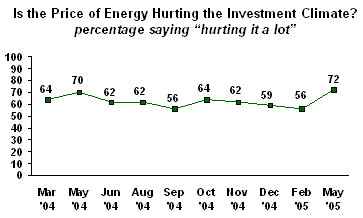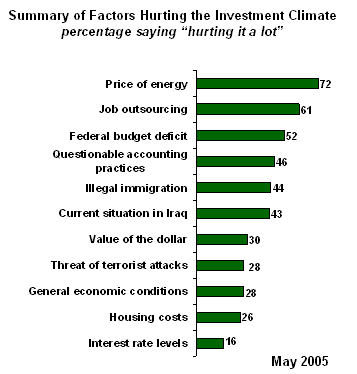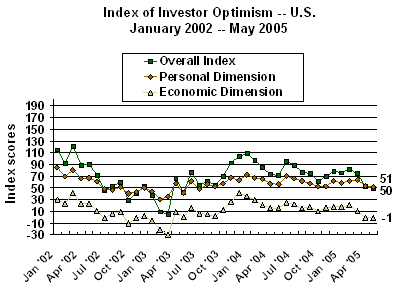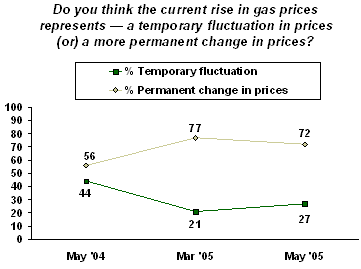GALLUP NEWS SERVICE
PRINCETON, NJ -- Gasoline prices hit a record $2.28 per gallon on April 11, according to the AAA. Evidently, this price level was high enough to change consumers' driving behavior, because gasoline demand fell last month to 9 million barrels a day -- 0.6% lower than a year ago, according to the American Petroleum Institute. Given this situation, it is little wonder that investor optimism remains weak and most investors say the price of energy is hurting the investment climate "a lot," according to the May Index of Investor Optimism Poll.
On the other hand, gas prices have fallen steadily since reaching their April peak and stand at $2.15 a gallon, as of May 18. Last week, Wall Street responded to declining oil prices with its best week in six months. How consumers respond to recent price declines at the pump, however, may well determine whether investors should stop worrying about a gas price-induced economic "soft patch" and begin worrying once more about a more aggressive Fed.
Gas Prices Are Creating Financial Hardship
Nearly half of all investors (47%) say higher gas prices are causing them financial hardship. This is up from 39% in March. Of those saying they are experiencing financial hardship, 29% say higher gas prices are causing them "a great deal" of hardship, while another 52% say prices are causing "a moderate amount" of hardship.

Energy Prices Remain the Top Investor Worry
Given the financial hardship that today's gas prices are creating, it is not surprising that energy prices top the list of investor worries in May, with 72% saying the price of gas and oil is hurting the current investment climate "a lot." This is up from 56% in February and is about equal to the 70% who felt this way a year ago.

Interest Rates Are at the Bottom of the Worry List
In sharp contrast to their concerns about energy prices, few investors seem worried about higher interest rates, even after a full two percentage-point increase in short-term rates over the past year. Only 16% of investors say the current level of interest rates is hurting the investment climate "a lot." This is virtually the same as the 15% who were concerned in February and the 14% who were similarly worried a year ago.

Other Investor Worries
Second among investor worries -- behind energy prices -- is the outsourcing of jobs to foreign countries, with 61% of investors saying this activity is hurting the current investment climate "a lot." Concerns over the federal budget deficit are next, with 52% of investors saying it is hurting the investment climate "a lot." These are followed by questionable accounting practices (46%), illegal immigration (44%), and the current situation in Iraq (43%).

Investor Optimism Remains Weak
Even though gas prices declined somewhat during the first half of May, investor optimism remains essentially unchanged, according to the UBS/Gallup Index of Investor Optimism. The May Index slipped to 50 from 52 in April. More significantly, investor optimism remains very weak, with the Index at its lowest level since May 2003, when it stood at 42.

Gas Prices and Consumer Psychology
In February, Gallup consumer and investor data suggested that those on Wall Street who said the economy could continue to build economic momentum, even with $50-a-barrel oil prices, were misreading the public perception of energy prices. Unlike Wall Street, Main Street tends to focus on gas prices at the pump, not oil prices in the international markets. As a result, when gas prices shot past $2 per gallon and kept rising in March, it was not surprising that Gallup's data showed consumer confidence plunging in late March and investor optimism following suit in April. Of course, the plunge in optimism was not only a reaction to soaring gas prices but also to the growing conviction among consumers and investors alike that higher gas prices are more permanent than temporary.
Now the question is how consumers and investors will perceive the declining gas prices of the past several weeks. So far, it looks like most investors are viewing the recent drop in prices at the pump as temporary. Seventy-two percent of investors say the rise in gas prices is more of a permanent change than a temporary event. This is down slightly from the 77% who held this view in March, but is substantially higher than the 56% who perceived a permanent change in gas prices a year ago.
Further, investors are forecasting pump prices of $2.32 a gallon six months from now, up from their March prediction of $2.21 a gallon.
On the other hand, there may be something psychological about the $2-per-gallon price level. If gas prices fall below this level and remain below it for a significant period of time, consumer and investor perceptions could shift once more. Many investors may decide that the surge in gas prices earlier this year was temporary, not permanent.

Economic Implications
A significant drop in gas prices at the pump will have the same positive economic impact as a tax cut. If it can be sustained, the resulting boost in consumer disposable incomes can only help the economy, as consumers increase their spending on other things. A prolonged drop in gas prices below $2 a gallon could also lead to a significant improvement in consumer confidence and investor optimism. Of course, a stronger economy and increased optimism would also give the Fed more room to continue pursuing its policy of steadily increasing short-term interest rates. As a result, investors may end up being more concerned about interest rates and less concerned about energy prices later this year.
Still, it is not clear that the current gas price declines can be maintained. According to the AAA, a record 37.2 million Americans will take trips during the Memorial Day holiday weekend -- an increase of 2.2% over last year. About 31.3 million, or 84%, are expected to do so by automobile. If this turns out to be the case, it isn't likely that May's demand for gasoline is going to be below that of a year ago, as was true in April. If the demand for gasoline increases again, then gas prices are likely to follow.
Survey Methods
Results for the Index of Investor Optimism poll are based on telephone interviews with 802 investors, aged 18 and older, conducted May 1-15, 2005. For results based on the total sample of investors, one can say with 95% confidence that the maximum margin of sampling error is ±4 percentage points. In addition to sampling error, question wording and practical difficulties in conducting surveys can introduce error or bias into the findings of public opinion polls.

